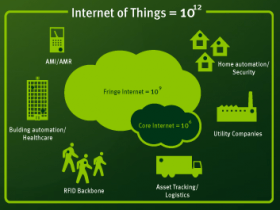
Since 1980‘s and 1990‘s we were constantly talking about world globalization and how interconnected we have become, partially thanks to the internet. In todays world, I think we need to coin a new term “internetiolization”, if we can pronounce it that is.
You might think that you live in the world of the internet, where everything is connected. But in truth, you have no idea how interconnected its about to get. Thanks to companies such as Sensinode out of Oulu, Finland, every little device is going to be able to communicate to every other little device and be connected to the global “Internet of Things”.
 Just imagine for a second that every light switch, device (TV, Fridge) and door lock in your house being connected to each other and the internet. So that you can adjust the overall brigthness of your living room to your preferred level of lumens. Now imagine that you can do that from anywhere in the world, through your mobile phone? Cool, right?
Well, it gets better. All of these devices could theoretically be connected to a wider grid, containing for example street lights. The system could then measure the amount of light that your house emits, couple it together with the amount of light needed on the street and power the street lights accordingly. If you connect light sensors and motion sensors to the grid, you can have the lights follow your car on a highway and not have any lights anywhere where it is not needed. This interconnectedness is what machine to machine communications could become. This new internet can and will be an order of magnitude bigger than what we currently have.
Just imagine for a second that every light switch, device (TV, Fridge) and door lock in your house being connected to each other and the internet. So that you can adjust the overall brigthness of your living room to your preferred level of lumens. Now imagine that you can do that from anywhere in the world, through your mobile phone? Cool, right?
Well, it gets better. All of these devices could theoretically be connected to a wider grid, containing for example street lights. The system could then measure the amount of light that your house emits, couple it together with the amount of light needed on the street and power the street lights accordingly. If you connect light sensors and motion sensors to the grid, you can have the lights follow your car on a highway and not have any lights anywhere where it is not needed. This interconnectedness is what machine to machine communications could become. This new internet can and will be an order of magnitude bigger than what we currently have.
According to Adam Gould, the CEO of Sensinode, there are going to be nearly 1 billion connected nodes by 2015. However there are still some problems in this industry, mainly the fact that there are a lot of proprietary protocols that never really scale.
So the only solution is to develop a standards based technology, which is what Sensinode is aiming to achieve. Moreover, as Gould points out, many of those nodes (devices) have battery requirements of 20 years or more, such as the gas meter in your house, so it is crucial to minimize costs and power consumption requirements.
 So far, Sensinode was able to develop a system that provides secure data transport between nodes, provides management of the data and also a web based API in order to allow customers to create applications.
So far, Sensinode was able to develop a system that provides secure data transport between nodes, provides management of the data and also a web based API in order to allow customers to create applications.
One popular use of the technology is also in the asset tracking business. For instance one of their clients is using nodes on sheep collars in order to track those stranded sheep at the end of the day. Of course you can also have slightly more standard assets such as shipping containers. So, as you can imagine, there are a lot of verticals for this technology.
The company has been around for 7 years and has went through a number of funding rounds. Starting from Angel investments and Tekes funding, followed by a Series A in 2010 and Series B a year later. One of the latest investments was done by Conor VC.
Gould tells us that it takes a very long time to set-up and develop a standardized technology and that “the silicon needed to make internet of things market was just too expensive until recently. The market is now starting to take off.” We certainly can’t wait to see this technology in commercial use.
To get a feeling for how it could work, you can play around with the back-end demo of it here:
Connected Home – Backend Demo (Username: demo / Password: demo)
Street Lightning – Backend Demo (Username: demo / Password: demo)
What uses can you think of for this type of technology and machine to machine communication? Is it something that is going to change the world as we see it? Let us know in the comments.




